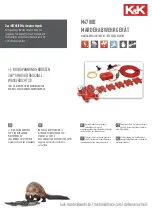
NL116 Ethernet and CompactFlash
®
Module
EXAMPLE 7-5. Run Program from CRD: Drive.
'Leave program on CRD:, run always, erase CRD: data files
13,toobigforcpu.cr1,crd:
EXAMPLE 7-6. Run Program Always, Erase CF Data.
'Run always, erase CRD: data files
13,pwrup_1.cr1,crd
EXAMPLE 7-7. Run Program Now, Erase CF Data.
'Copy run.cr1 to CPU:, erase CF data, run CPU:run.cr1, but not if later powered up
14,run.cr1,cpu:
7.2.4 Camera Files
JPEG images taken by a CC640 digital camera (retired) connected to the
datalogger can be stored to the CF card rather than CPU memory. This is done
by configuring the PakBus setting
Files Manager
for the datalogger. This can
be done using
DevConfig
or
PakBus Graph
.
7.3 Programming
7.3.1 The CardOut() Instruction
The
CardOut()
instruction is used to send data to a CF card.
CardOut()
must
be entered within each
DataTable()
declaration that is to store data to the CF
card. Data is stored to the card when a call is made to the data table.
CardOut(StopRing, Size)
Parameter
Data Type
Enter
StopRing
Constant
A code to specify if the data table on the CF card is fill-and-stop or ring (newest data
overwrites oldest).
Value Result
0
Ring
1
Fill and stop
Size
Constant
The size to make the data table. The number of data sets (records) for which to allocate
memory in the CF card. Each time a variable or interval trigger occurs, a line (or row) of
data is output with the number of values determined by the output instructions within the
table. This data is called a record.
Note
Enter –1000 and the size of the table on the card will match the size of the
internal table on the datalogger. Enter any other negative number and all
remaining memory (after creating any fixed-size data tables) will be allocated to
the table or partitioned among all tables with a negative value for size. The
partitioning algorithm attempts to have the tables full at the same time.
23
Summary of Contents for NL116
Page 2: ......
Page 6: ......
Page 38: ...NL116 Ethernet and CompactFlash Module 30 ...
Page 43: ......














































